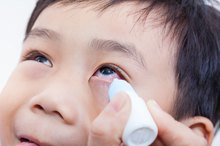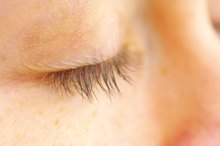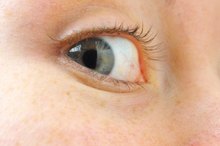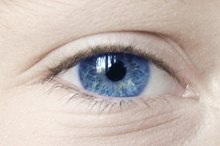Causes of a Bump on the Lower Eyelid
Eyelid bumps can develop suddenly or gradually, appearing as a knot beneath the skin or a surface growth. Bumps generally occur on the upper or lower eyelid for similar reasons.
Common causes include a sty or blocked oil gland. Noncancerous and cancerous growths are also possible culprits. Medical evaluation is needed for any unexplained bump on the lower eyelid.
Sty
Sudden development of a red, painful lump of the lower eyelid is most commonly due to a sty, known medically as a hordeolum. This common eye ailment affects people of all ages. A sty occurs due to a bacterial infection of an eyelash hair follicle, or an eyelid sweat or oil gland. The bump often resembles a pimple, but the entire affected eyelid may be red and swollen. **A sty usually develops near the rim of the eyelid.
** Application of warm compresses to the affected eyelid several times daily often leads to drainage of the sty and healing. However, if the sty fails to improve within two days or worsens, antibiotics or a minor procedure to drainage the pocket of infection may be necessary.
- Sudden development of a red, painful lump of the lower eyelid is most commonly due to a sty, known medically as a hordeolum.
- A sty occurs due to a bacterial infection of an eyelash hair follicle, or an eyelid sweat or oil gland.
Chalazion
Itchy Eyelash Follicles
Learn More
The eyelids contain meibomian glands, which open at the rim of eyelid. They secrete an oily substance that lubricates the eye and slows the evaporation of tears. A blockage in one of these glands typically causes an eyelid bump called a chalazion, which most commonly affects adults. Although the gland is not infected, the blockage causes inflammation that leads to development of a firm lump. A chalazion can develop suddenly or gradually. Those that develop quickly are often accompanied by redness, and eyelid swelling and tenderness.
Chalazions that develop more gradually are often painless and typically appear as a firm lump with minimal eyelid discoloration and swelling.
Gentle eyelid scrubbing and warm compresses applied several times daily may lead to drainage of the blocked gland and healing. A large or treatment-resistant chalazion, however, may require drainage by an eye doctor.
- The eyelids contain meibomian glands, which open at the rim of eyelid.
- Chalazions that develop more gradually are often painless and typically appear as a firm lump with minimal eyelid discoloration and swelling.
Noncancerous and Cancerous Growths
Several types of growths, or tumors, can develop on the lower eyelid and cause a small to large bump. Eyelid growths can occur in children, but are more common in older adults 3. Many are benign, or noncancerous, but others are cancerous. Noncancerous tumors -- with tongue-twisting names like squamous papilloma, seborrheic keratosis and syringoma -- arise from different tissues in the eyelid, such as the skin and sweat glands. The same holds true for cancerous eyelid tumors, although the overwhelming majority arise from skin cells. Basal cell carcinoma accounts for 80 to 90 percent of cancerous eyelid tumors, and the lower lid is affected more frequently than the upper lid. Squamous cell carcinoma and melanoma are other types of skin cancer that can develop in the eyelids. Cancerous tumors arising from other types eyelid tissues, such as a sebaceous carcinoma developing in a meibomian gland, are relatively rare.
- Several types of growths, or tumors, can develop on the lower eyelid and cause a small to large bump.
- Basal cell carcinoma accounts for 80 to 90 percent of cancerous eyelid tumors, and the lower lid is affected more frequently than the upper lid.
How to Get Rid of Styes in Your Eyelids
Learn More
**If you suspect you have a sty, the safest course of action is to call your healthcare provider and relate your symptoms to see if a few days of home treatment is an appropriate course of action.
** For all other bumps that develop on the lower eyelid, it is best to visit your doctor for a thorough examination and possible testing. It’s important not to ignore slow-growing or painless eyelid growths, as these characteristics are typical of cancerous tumors of the eyelids. Seek urgent medical care if you experience a sudden change in vision, eye pain, or spreading redness extending from the eyelid to the surrounding skin.
Reviewed and revised by: Tina M. St. John, M.D.
- If you suspect you have a sty, the safest course of action is to call your healthcare provider and relate your symptoms to see if a few days of home treatment is an appropriate course of action.
- Seek urgent medical care if you experience a sudden change in vision, eye pain, or spreading redness extending from the eyelid to the surrounding skin.
Related Articles
References
- Ocular Pathology, 7th Edition; Myron Yanoff, et al.
- Pfenninger and Fowler's Procedures for Primary Care, 3rd Edition; John L. Pfenninger, et al.
- Eyelid Tumors, 2nd Edition; Jay Justin Older
- Duane's Ophthalmology; William Tasman and Edward A. Jaeger
- Ogazi I. Q&A: Eyelid cancer. The University of Texas MD Anderson Cancer Center. March 11, 2016.
- American Society of Clinical Oncology Cancer.Net. Eyelid cancer: Statistics. Updated January 2020.
- American Society of Clinical Oncology Cancer.Net. Eyelid cancer: Overview. Updated August 2015.
- The University of Texas MD Anderson Cancer Center. Eye cancer.
- Finger PT. Sebaceous carcinoma of the eyelid. New York Eye Cancer Center.
- American Society of Clinical Oncology Cancer.Net. Eyelid cancer: Stages and grades. Updated August 2015.
- American Society of Clinical Oncology Cancer.Net. Melanoma: Stages. Updated August 2020.
- American Society of Clinical Oncology Cancer.Net. Eyelid cancer: Symptoms and signs. Updated August 2015.
- American Society of Clinical Oncology Cancer.Net. Eyelid cancer: Risk factors. Updated August 2015.
- American Society of Clinical Oncology Cancer.Net. Eyelid Cancer: Diagnosis. Updated August 2015.
- American Society of Clinical Oncology Cancer.Net. Eyelid cancer: Treatment options. Updated August 2015.
- American Society of Clinical Oncology Cancer.Net. Eyelid cancer: Coping with side effects. Updated August 2015.
Writer Bio
Kate Beck started writing for online publications in 2005. She worked as a certified ophthalmic technician for 10 years before returning to school to earn a Masters of Fine Arts degree in writing. Beck is currently putting the finishing touches on a novel.









